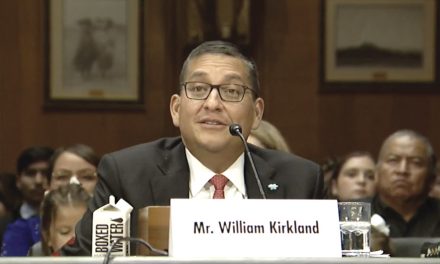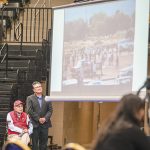
Letters: Parents need to question, not just accept

education promo
Graduations are over and summer break is here, then back-to-school for the next young eager minds.
Meanwhile there is a controversial reform going on in our education system — public versus privatizing.
President Obama has asked Congress for a 50 percent increase funding for charter schools.
The Navajo Times has been publishing some articles about charter schools and no response from the public or investigative journalism done and left me curious.
A rosy picture about how great this system of education is portrayed by people inside pushing for charter schools bothered me.
How did charter school gain so much national dominance against a traditional education system?
I looked into the background of this organization and did some reading and here are some important information I found about charter schools.
Charter schools have been operating for 20 years under a federal budget of $3 billion dollars pushed into Congress by businessmen to privatize education.
Charter schools have nearly no oversight, regulation or accountability.
Why is it questionable?
Because they have no comprehensive database showing how funds are used to improve academic performance to compare to public schools.
A real lack of financial transparency with $3 billion at stake should have tremendous controls on spending like the public school system does.
For ordinary public schools, if we want to build a new gym or a new stadium, we have to ask the taxpayers for permission to expand the school system, have certified teachers, have a certain size student ratio to one teacher, choice of textbooks and curriculum.
I would like to know how students were serviced because it is siphoning a lot of money out of public schools to these charter schools.
School boards are the only way that we have democratic control over our schools.
Who is in control?
Parts of how charter schools came into being are scandalous, but that is not my interest.
When the word “private” became known in Wall Street, it perked the interest of money investors to move in on how to make a profit in education.
Huge political contributions were made behind charter school supporters.
So part of the federal stimulus money now being offered to every state are under the condition that they raise charter school caps.
They must tie teacher evaluations to students’ test scores.
If they are failing, they close the school.
Finally, they turn the school over to private operators.
While it’s true our education standing worldwide has been dropping toward the bottom, and the teachers have been blamed for this continued trend.
The truth is millions of dollars of resources are thrown into charter schools when the same resources should be used to make public schools better.
Instead of creating quality schools Obama is privatizing our public education system.
Our O’Malley and Impact Aid from federal funding have been continually cut, combined with underfunding by the state has caused firing and layoffs because of budget constraints.
Who is taking over?
If it is charter schools, it will dismantle our locally elected school boards which will mean no parent involvement when we turn our schools over to private operators through a turnaround.
This raises a lot of issues about where our tribal sovereignty stands, etc. , etc.
Past articles on charter schools praised how good and promising they are without statistics sounded like we should just give them a “carte blanche” invitation when the majority of us don’t know much about them.
Now, Obama’s request for more charter school money will increase cash floating around for private businesses seems like a setup for even more wasteful spending.
Parallel this thought with the enormous military budget wasted on private contractors standing in line for our tax money.
Lastly, charter school sounds too good to be true, like “a wolf in sheep skin.”
If they’ve been around for 20 years funded with our federal tax dollars, then there should be reports of an upward trend nationally and worldwide improvement in our education statusÑbut that’s not the case.
Parents and communities (need to) question more rather than just accepting without question.
Are they selective of students who are accepted?
How about remedial students?
Special needs for handicap?
Are all teachers certified?
What are parents saying about co-locates charter schools inside existing neighborhood public schools?
Who controls the school?
What are the impacts at the community level and how are students affected by this educational reform?
Etc. , etc. as a start.
Teddy Begay
Kayenta, Ariz.
Response on audit of Wide Ruins
Please accept this as a response to your article published on May 14, titled “Auditors find problems at Wide Ruins Chapter” .
The report clearly indicates the chapter was audited for a 15-month period beginning Oct.
1, 2012 ending Dec. 31, 2013, with an expenditure of almost $750,000.
Being a former president at Lupton Chapter, I thought Wide Ruins Chapter was getting some special treatment from the Navajo Nation Council when it came to allocation of tribal funds for each fiscal year.
The amount of dollars coded seems to be outrageous, but to put things in perspective the expenditures reported are for a period of over six years of chapter operation.
When I was the chapter president, in our meetings with the Local Governance Support Center staff, it was announced numerous times, the chapters within the Fort Defiance Agency all had their housing committees and veterans organizations organized.
It was also mentioned there were a great number of chapters who had their Community Land Use Plan approved and certified.
To my knowledge, Wide Ruins and Lupton chapters were among the first to form these committees and getting their Land Used Plan certified for full implementation.
I have always questioned the intervention of all outside sources, especially if it involved our financial operation and system.
It is my opinion the reporter should have taken time off to visit Wide Ruins Chapter for verification of all financial transactions he quoted in his report.
As a chapter official, I do recall questions that were never resolved when we were audited at Lupton Chapter in 2007.
The position was “The auditor general is always right.”
The auditors will always question and have great concern when they come across staff bonus, incentives, and salary adjustments.
Of course, the travel cost will always be an issue and the cost for major equipment will be cited even though it needed repairs or replacements.
I found the little payout made as staff bonus, incentives, or salary adjustments are permissible and allowed, as in accordance to the Navajo Nation Personnel Policies and Procedure.
We, as a nation, need to get more competitive and get out of the rut that continues to classify us as a Third World country.
I believe the auditor general is in a position to say, “The local chapter staff are overworked and underpaid and should recommend salaries increase, new positions and work towards creation of townships.”
In addition, I know selecting a sole source for professional contractual services is also permissible with proper justification, especially if it involves extreme emergencies, personal safety and the well-being of the general public.
In Lupton’s case, we had to hire a medicine man for traditional prayers, chants, and cleansing ceremony for our administrative offices and complex.
This was handled as a sole source and it served its purpose.
During our audit at Lupton, I have also noticed the auditors are more receptive to the negative influence that they encountered while conducting their review.
I thought they were supposed to be impartial and conduct their assessment in a professional manner.
By the way, Lupton Chapter passed the audit with flying colors and was all made possible by our staff and my other colleagues.
With these notations and inquiries, the article mentioned above should have been titled, “Wide Ruins Chapter finds problems with the auditor general.”
Paul Begay
Lupton, Ariz.
Why we oppose the Grand Canyon monument
As the chairman of the Arizona Game and Fish Commission, I want the public to know why the commissioners of one of the nation’s premier wildlife conservation organizations strongly oppose the creation of the 1.7 million-acre Grand Canyon Watershed National Monument.
The commission’s opposition is based on the negative impacts such a designation is likely to have on wildlife management across this vast expanse of northern Arizona.
A need to “fix” current management practices simply doesn’t exist.
Even the Center for Biological Diversity recently stated that this area already is being effectively managed, thanks to cooperation by several state and federal agencies.
The commission completely agrees.
The creation of the Sonoran Desert National Monument in 2001 is a cautionary tale.
In 1999, Arizona Game and Fish Department biologists counted 103 bighorn sheep in the Maricopa Mountains within the monument’s boundaries.
When the monument was designated, the department was allowed only limited access to provide new and sustainable water sources for wildlife.
Over the next 11 years, AZGFD experienced detrimental delays and prohibitions for many critical wildlife management actions while the Bureau of Land Management developed an overarching area management plan.
Today, surveys indicate fewer than 35 sheep roam this area.
Without a doubt, lack of access was a contributing factor to the steep decline in the sheep population.
This harsh lesson shouldn’t be repeated with any wildlife species anywhere else in Arizona.
The costs associated with creating – and maintaining – a national monument may well prove to be prohibitive.
A National Park Service report shows the Grand Canyon National Park already can’t afford $329 million in deferred maintenance, yet this proposal would add to that financial burden.
The proposed Watershed area spans 1.7 million acres, compared to Grand Canyon National Park’s 1.2 million acres, begging the question: If the federal government can’t operate and maintain a world class national park at 1.2 million acres, how can adding 1.7 million more acres to manage have a positive impact?
Transparency — or the lack thereof — also is a major issue in this process.
Where are the opportunities for input from Arizonans directly impacted by a monument designation?
Any such designation should come only after a robust and complete discussion among Arizona stakeholders.
The department’s mission is to speak on behalf of the well-being of wildlife that doesn’t have a voice.
Unfortunately, in this process, Arizonans don’t have a voice either.
Arizonans deserve a transparent public process.
The 1.7 million acres already being successfully managed will instead be subject to deferred management, budget shortages and increased bureaucracy.
As chairman of the Arizona Game and Fish Commission, I respectfully submit that these lands should continue to be responsibly managed under the jurisdiction of the Forest Service and BLM and should not be designated a national monument.
Robert E. Mansell
Chairman
Arizona Game and Fish Commission
Winslow, Ariz.
There was no majority vote in this election
What’s the whole ordeal with Navajo language fluency?
We have thousands of people within the reservation that can’t speak or understand Navajo.
Even six of our council delegates can’t speak it.
The speaker of the council is one in particular.
Most of the discussions at the council chamber meetings are done in English.
That will be the day when all the talk is done in Din.
In the newspapers they claim “the people have spoken” .
They (Shirley/Begaye) don’t know what they are talking about.
There was no majority vote in this election.
If you know math, you can pretty much calculate the percentage of votes in any election.
Russell Begaye/Jonathan Nez received 25,902 votes out of the 118,673 voters that registered.
That’s only 22 percent of the Navajo voters.
Joe Shirley/Dineh Benally got 15,245 votes.
That’s 13 percent.
All total 44,162 voters cast their ballots.
That’s 37 percent of the Navajo Nation.
If 51 percent of the Navajo voters would have voted, I would have said it’s fair for the losing candidates, but this is ridiculous.
Is there a law or quorum type count that is on the Navajo Nation Election books?
Less than a fourth of the Navajo people elected Mr. Begaye and Nez.
It would have been exceptionally great if one or both candidates would have said “Postpone the election and let’s look at the referendum.
Let the people decide who they want as their leader.”
Yet the “I want” mentality kicked in for both men.
Check this out! Transparency or wool over everyone’s eyes?
Who is Russell Begaye?
Who is our Navajo Nation first lady?
What college did he get his degree from and for what profession?
What are his accomplishments as Shiprock Council delegate?
What other credentials or things need mentioning?
Picking Jonathan Nez as a running mate was an excellence move.
He slid into Window Rock on his coattail.
I predict that it’s going to be a time like what an old chief said about the U.S. government, “They make thunder, lightning, and hot air, but there is no rain.”
Nelson Lee
Nenahnezad, N.M.
Threats to sacred sites, namely the Confluence
Proponents to the Grand Canyon Escalade Project were jolted by the outcome of the presidential elections.
Throughout their campaign the new president Russell Begaye and Vice President Jonathon Nez voiced their displeasure of this controversial endeavor by the Confluence Partners with the support from the former president.
It is a relief to the families that have spoken outright against the destruction of this sacred site and who over the four years suffered through the confusion inflicted by the CPs.
Sadly, the biggest disaster was the politics that divided the small community of Gap/Bodaway.
The beginning was the spring of 2009 about the time when the Bennett Freeze was lifted.
The Gap/Bodaway Chapter meeting listed the Confluence area for development.
Then Vice President Ben Shelly and other tribal officials were present.
They wanted that area for economic gain for the Navajo Nation.
We, the Save the Confluence families, did not know what we were in for.
Three times the project was either tabled or voted down.
In the summer of 2011 the Confluence families invited newly elected Shelly to the Confluence.
He toured the site, offered a prayer with corn pollen, and stated that this area would be off limits for development.
About a year later Shelly and the CPs agreed to a MOU to do a feasibility study towards development.
The Confluence families began a campaign against greed and political power.
One of my sisters, a grazing permit holder, went out of her way to collect signatures at public events.
With the help of others, they gained the support of 3,000 people.
Organizations like the Grand Canyon Trust and environmental activists stood with the Confluence families.
Our neighbors, the Hopi and the Pueblo people, gave us unquestionable support because the Confluence is also sacred to them.
The website, SavetheConfluence.com designed by an in-law, reached out for support to the Navajo Nation, to the national level and to the world.
We did not know that people in global countries supported our struggle.
Yet the former president and the CPs continued to push the project forward.
Residents against the effort were subjected to intimidation by threats that they would lose their grazing permits.
They were successful in pitting one family against another, and thereby destroying relationship on Ke’.
Rumors and gossips generated by both sides did not promote harmony.
In October 2012, a respected and prominent leader was escorted by the police out of a chapter meeting for voicing her objection to the Escalade.
Earlier that year, in a different venue, this woman actually quieted an unruly crowd that was disrupting Shelly’s speech on the Navajo water rights at Tuba City when Senators McCain and then Senator Kyle were pushing an agenda to deprive the Navajo and Hopi people of their water rights.
Following that bad public relations incident at the Gap Chapter meeting the CPs said that their initiative would be on hold for a year.
Yet behind the scenes they were still lobbying the Council delegates for support.
And negotiations between Shelly and the CPs were still going on without public disclosure.
This continued up to the presidential elections and inauguration.
Shelly went so far as to give a list of projects that he wanted the new president to complete.
The Escalade was at No. 3.
Voters at Gap/Bodaway Chapter, the epicenter of this controversy, turned down the project by 202 votes to 88.
And the 27 chapters of Western Agency voted 4,614 for Begaye/Nez to Shirley/Benally’s 1,602.
We understand that threats to sacred sites across Native American lands will continue and it is up to the people to protect the sites from destruction.
William LongReed
Tuba City, Ariz.
Leadership needs to be reorganized for Dine College, NTU
The Navajo Nation has two institutions of higher learning: Din College and Navajo Technical University.
Each is chartered to “meet the specific needs of the Navajo Nation.”
DC provides liberal arts transfer education while NTU provides technical education.
Recently, NTU has begun to offer baccalaureate education in Din studies, leadership and creative writing.
DC offers two baccalaureate programs in teacher education and tribal management.
The two tribal colleges appear to want to go in the same direction.
They appear to look the same.
I make the argument that the Navajo Nation government reorganize the top leadership for the two tribal colleges, DC and NTU, to have one higher education Board of Regents and college president.
There are states that have one higher education State Board of Regents.
Arizona is an example.
There are many good reasons, of which I will mention a few here, for reorganizing the top leadership for the two higher education institutions on the Navajo Nation.
First and foremost, one Board of Regents and president will benefit all Navajo students.
One Board of Regents and president can establish policies for both tribal colleges under a one-college concept to benefit all Navajo students.
A benefit to students includes a seamless student migration between the two tribal colleges making course transfer a thing of the past.
Students benefit from access to streamlined associate and baccalaureate degree programs offered by both tribal colleges.
Students benefit from both institutions shared faculty expertise.
One Board of Regents and president could also institute offering the first two years of college skills development for free to all students as proposed by President Barack Obama allowing students to use their scholarships more efficiently.
They could also set an escalated nation building strategic goal for both tribal colleges to become research universities offering advance degrees and research to benefit the Navajo Nation in the next decade.
For DC and NTU, the benefits include eliminating the competition for the same Navajo student(s) and sharing resources with one mission and purpose.
For the nation, the benefits include eliminating the two colleges competing for the same federal and Navajo Nation dollars.
These are, as I see it, a few of the benefits for one higher education Navajo Nation Board of Regents and college president.
I want to make a point on credentialing and membership.
It is of paramount importance that the members of this higher education Navajo Nation Board of Regents and college president have proper credentials so they understand the mission and purpose of higher education.
The higher education Navajo Nation Board of Regents be non-political and made of no more than three members.
The student regent members from both tribal colleges must remain.
In concert with higher education shared governance faculty representation is important.
It is time to make practical and necessary changes to the top leadership of the two tribal colleges operating on the Navajo Nation and make it one so they are more efficient and effective in meeting the needs of all Navajo students.
After all, I am not saying we should go to the moon, just regroup to make things better for students and the nation’s higher education system.
Paul Willeto
Aztec, N.M.
To read the full article, pick up your copy of the Navajo Times at your nearest newsstand Thursday mornings!
Are you a digital subscriber? Read the most recent three weeks of stories by logging in to your online account.








 Highway 264,
Highway 264, I-40, WB @ Winslow
I-40, WB @ Winslow